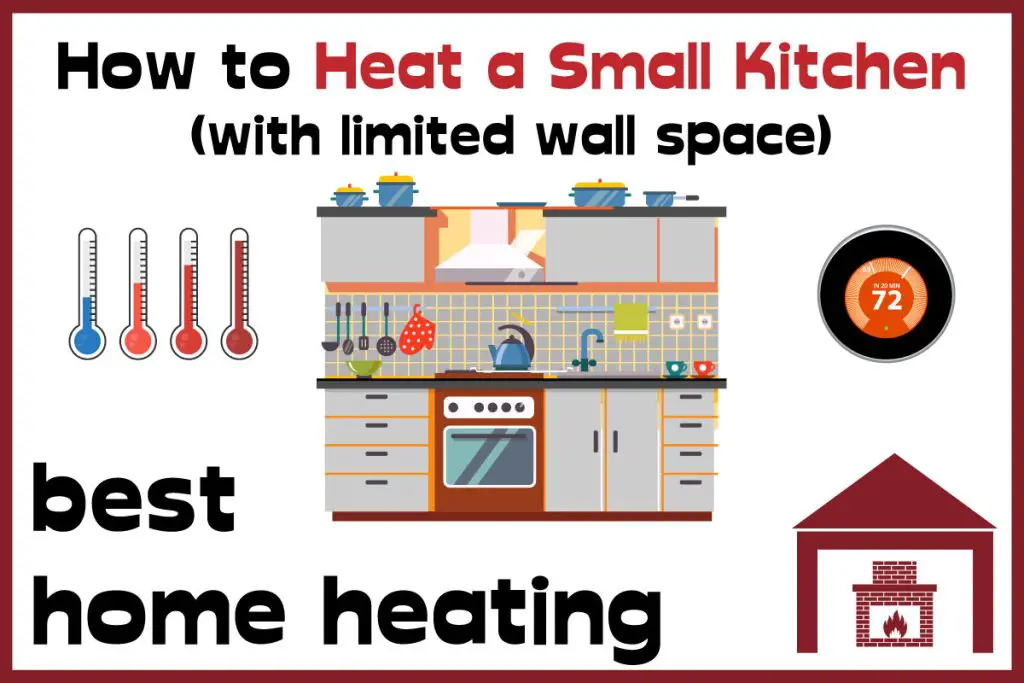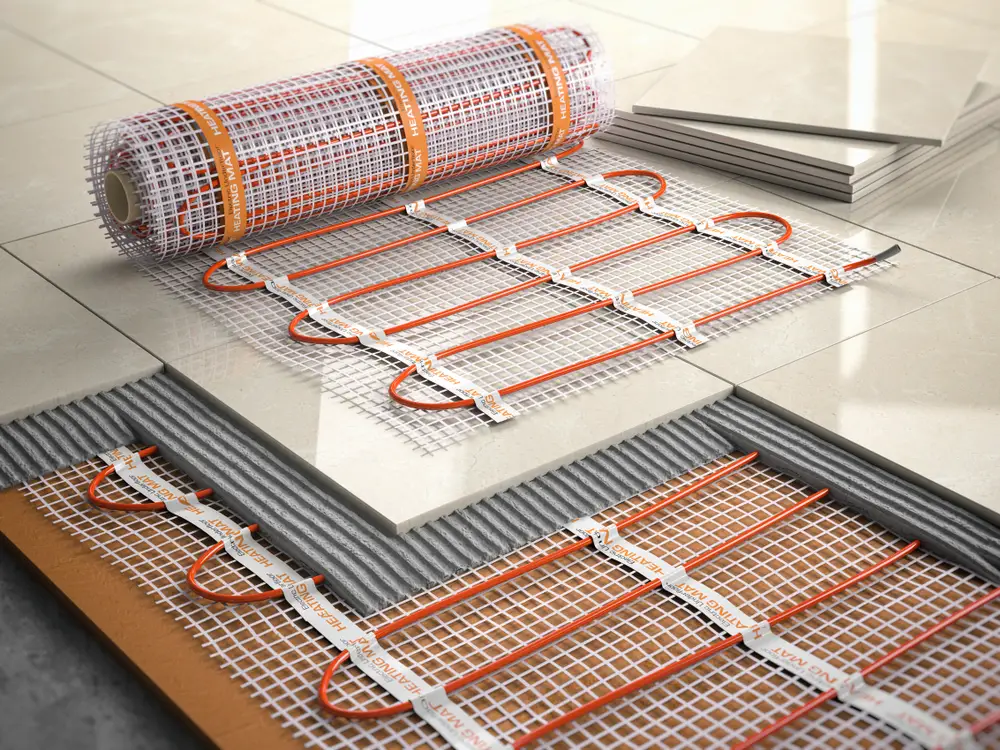In a small kitchen, your heating options are limited, and you have only three good choices: Plinth Heaters, Underfloor Heating, and Skirting Board Heating, with Plinth Heaters being the most convenient among them.
Efficiently heat small kitchens with Plinth heaters & Underfloor systems – no wall concerns. Plinth heaters fit under cabinets, using minimal space. Underfloor systems are hidden under the floor, leaving no visible footprint.
Interested in discovering optimal heating solutions for small kitchens with limited wall space? Read on to find out more!

Plinth Heaters
Plinth heaters are small heaters used in areas with inadequate space for radiators or other heating systems. A plinth heater can be neatly fitted in the little space under your kitchen cupboard.
Plinth heaters are available in hydronic and electric models, and they work in similar ways as radiators. A hydronic plinth is plumbed into your home’s central heating system. When the central heating is on, the plinth heater automatically switches on.
Some hydronic models include electric heating elements as well. A hydronic plinth heater takes some time to warm up. An electric model, in contrast, provides warmth instantly. The heated elements inside the units are, however, somewhat power-hungry.
The process of installation is not very complicated, but you will need some plumbing skills if you choose a hydronic system.
Plinth heaters cost between $200-$300. If you choose a hydronic system, the plumber will charge $50-$70 per hour for installation. For each 1kw of heat, a plinth heater costs around 20 cents per hour.
Plinth heaters do not take up space in your kitchen because the compact unit can be neatly fitted into the plinth or kickboard underneath a kitchen unit. It’s a great option for a small kitchen.
Pros and Cons of Installing a Plinth Heater in a Small Kitchen
| Pros | Con(s) |
| Plinth Heaters are a space saving and heating compact solution. | Electric models are not as energy-efficient as hydronic models |
| It does not take up wall space. | |
| Hydronic models are remarkably energy efficient. | |
| Installation and running costs are lower than those of underfloor heating |

Underfloor Heating
Underfloor heating (UFH) is arguably the best option to heat a small kitchen with no wall space. The system turns your entire kitchen floor into a heat emitter, giving you space for cabinetry.
There are two types of underfloor heating systems: hydronic and electric. A hydronic system involves installing pipes under the floor. Hot water, which receives heat from your central heating system, runs through the pipes. As a result, your kitchen floor radiates heat, keeping the room comfortably warm.
An Electric UFH involves installing heating mats beneath the floor. The temperature of the mat is controlled by a thermostat.
Installation costs of underfloor heating vary, but if it is a renovation project, you can expect to pay $150-$200 per square meter for a hydronic system and $70-$100 per square meter for an electric system. If it is a new build project, you will have to pay $140-$160 per square meter for a hydronic system and $60-$90 per square meter for an electric system.
The running cost of a hydronic system is lower than that of an electric system. If you install a heating mat in a 6m²-kitchen and the system runs for 2 hours a day, it will cost around $7 per month. This amount can be significantly lower or higher depending on the price of electricity.
It’s a bit tricky to figure out the running cost of a hydronic UFH system, but it’s always lower than that of an electric system.
Underfloor heating, particularly a hydronic system, is remarkably energy-efficient. You can significantly reduce your carbon footprint by pairing your UFH with a ground source or air source heat pump.
The most notable advantage of UFH is that it does not take up space in your kitchen. However, it slightly raises the height of your kitchen floor.
The only drawback of this option is that it has a high upfront cost, especially if you choose a hydronic system.
Click on the link for more information on Kitchen underfloor heating from BestHomeHeating.
Pros and Cons of installing Underfloor Heating in a Small Kitchen
| Pros | Con(s) |
| It eliminates the need for radiators, saving valuable space for cabinetry. | High upfront costs |
| It is highly energy efficient. | |
| Underfloor Heating systems distributes heat evenly. |

Skirting Board heating
Skirting Board heating is an ingenious way to heat a kitchen with no space for a conventional heating system. Skirting boards have conventionally served aesthetic purposes by hiding the meeting point of the floor and the wall. They are now serving an additional purpose: heating.
A heating system is installed inside the skirting board. Just like radiators, skirting board heating systems come in two different types: hydronic and electric. A hydronic system is plumbed into your home’s central heating system and an electric system is connected to a power outlet.
From the outside, a skirting board used for heating looks the same as one used for aesthetic purposes. A notable advantage of a skirting board system is that it distributes heat evenly—almost as evenly as underfloor heating.
If there are skirting boards installed in your small kitchen, skirting board heating is the best option for you.
The installation cost for skirting board heating is around $40 per linear meter. If you choose an electric system instead, an electrician will charge around $250 per day. For a hydronic system, you will have to hire a plumber and pay $300-$400 per day.
Pros and Cons of using Skirting Board heating in a Small Kitchen
| Pros | Con(s) |
| It can be installed in pre-existing skirting boards. | Not very efficient in a kitchen with poor insulation |
| Skirt Boards do not take up wall space, floor space is not encroached on | |
| It distributes heat evenly. | |
| Easy installation. |
Heating Methods to Avoid due to Space Concerns
There are some methods of heating that are not suitable for small kitchens. They take up too much space, and they can cause safety hazards. Here are two options that should be avoided if you have a small kitchen:
1. Horizontal radiators
While radiators are among the most widely used heating methods, horizontal radiators are not suitable for small kitchens, because the units take up too much wall space. A vertical radiator also takes up some wall space, but only vertical space.
So, if you want to use a radiator to heat a small kitchen with very little wall space, get a tall and slim radiator rather than a short and wide one.
2. Fireplaces
Using a wood-burning fireplace in a small kitchen is a terrible idea. First, it takes up a substantial amount of space in the kitchen. Second, it can potentially create fire hazards because a small kitchen is unlikely to have very good ventilation. And third, the fireplace emits smoke, which is harmful to your health. It can cause respiratory diseases like pneumonia and bronchitis.
While good insulation is important for modern heating systems such as underfloor heating, radiators, and plinth heaters, it can actually make a conventional fireplace dangerous.
Conclusion
If you have a small kitchen, it is important to be careful when choosing a heating system. In general, electric underfloor heating is a great option for a small kitchen. However, depending on your heating needs, you may choose a plinth heater or skirting board heating system.
Also, make sure you stay away from options that are inconvenient and potentially dangerous for small kitchens. We hope you are now ready to make an informed decision.
